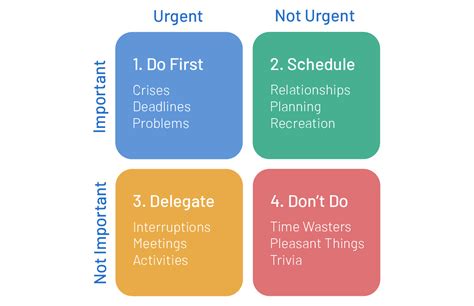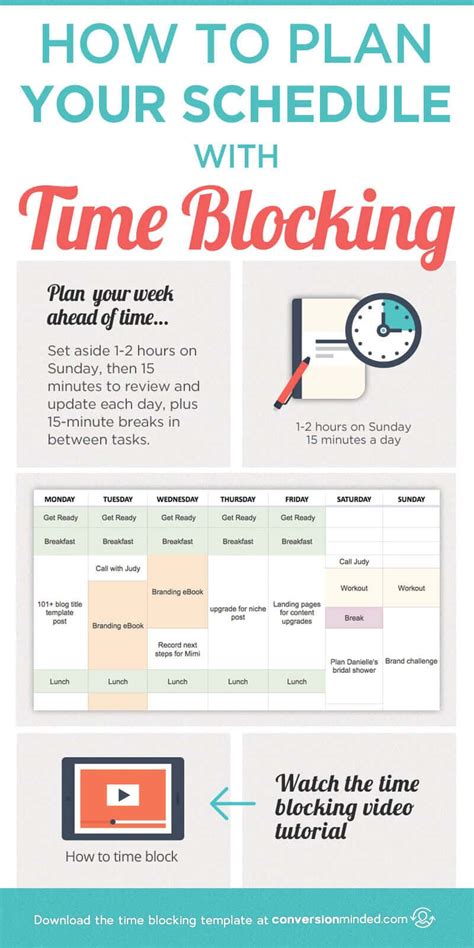As ambitious individuals striving for success in our fast-paced world, we often find ourselves grappling with the mounting pressure to accomplish goals within strict deadlines. However, mastering the art of time management is an invaluable skill that can revolutionize our productivity levels and help us achieve both professional and personal fulfillment. By harnessing a diverse range of effective strategies and implementing them into our daily routines, we can not only enhance our capabilities but also unlock our true potential.
Firstly, prioritizing tasks is a fundamental aspect of effective time management. By utilizing your discernment and focusing on high-priority activities, you can channel your energy towards tasks that truly matter and contribute to your overall progress. This approach empowers you to identify the vital elements of each project, ensuring that you devote your time and effort to the most impactful aspects. When armed with a clear understanding of your goals and objectives, you can make informed decisions on where to invest your limited resources.
In addition to prioritization, incorporating efficient planning techniques is crucial for optimizing your time. Establishing a structured schedule and setting specific goals enable you to become more organized and stay on track. Utilize tools such as calendars, to-do lists, and project management applications to break down your tasks into manageable steps, ensuring that you allocate sufficient time for each activity. By providing yourself with a roadmap and allocating time blocks for different responsibilities, you can prevent the chaos of last-minute rushes and create a sense of structure throughout your day.
Moreover, it is important to recognize the significance of self-discipline in the pursuit of effective time management. While it may be tempting to succumb to distractions or procrastination, developing the ability to maintain focus and resist distractions is paramount. Employ techniques such as the Pomodoro Technique, which involves working for a set period, followed by a short break, to enhance concentration and avoid burnout. Cultivating self-discipline requires consistent practice and commitment, but the rewards of increased productivity and reduced stress are well worth the effort.
Ultimately, the value of time management lies in its ability to empower individuals to take control of their lives and accomplish more in less time. By adopting various techniques such as prioritization, planning, and self-discipline, you can transform your approach to time and unlock a world of possibilities. Embrace these indispensable strategies and witness the transformative impact they can have on your productivity, success, and overall well-being.
Prioritize Your Tasks for Effective Time Allocation

In order to make the most of your time and increase your efficiency, it is crucial to prioritize your tasks effectively. By determining the importance and urgency of each task, you can allocate your time wisely and focus on what truly matters.
Identify Your High-Priority Tasks: Start by identifying the tasks that require immediate attention or have significant impact on your goals and objectives. These tasks are essential for achieving success and should be given top priority.
Consider Deadlines and Time Constraints: Evaluate the deadlines and time constraints associated with each task. Tasks that have tight deadlines or are time-sensitive should be prioritized accordingly to ensure timely completion.
Weigh the Importance and Impact: Assess the importance and impact of each task on your overall objectives and long-term goals. Prioritize tasks that contribute directly to your success and align with your priorities.
Categorize Tasks by Urgency: Divide your tasks into categories based on their urgency. Identify tasks that require immediate attention and those that can be handled at a later time. This will help you determine which tasks should be tackled first.
Consider Complexity and effort Required: Take into account the complexity and effort required for each task. Prioritize tasks that are more complex or time-consuming, as they may require more focus and attention.
Use Time Management Techniques: Utilize effective time management techniques such as the Eisenhower Matrix or the Pomodoro Technique to prioritize and allocate your time efficiently. These techniques can help you make informed decisions about task prioritization.
Regularly Review and Adjust: Regularly review and adjust your task priorities as needed. As new tasks arise or circumstances change, it is important to reevaluate and reallocate your time to ensure optimal productivity.
By prioritizing your tasks effectively, you can optimize your time management and enhance your overall productivity. With a clear focus on what needs to be done and when, you can accomplish more and achieve your goals more efficiently.
Stay Focused by Setting Clear and Achievable Objectives
One of the crucial aspects of enhancing productivity and managing time effectively is to establish well-defined and realistic goals. Having clear objectives gives you a sense of direction, allowing you to stay focused and motivated throughout your tasks.
When setting goals, it is essential to ensure they are specific and measurable. By clearly defining what you want to achieve, you eliminate ambiguity and provide yourself with a clear target to strive for. This specificity helps you concentrate your efforts and avoid wasting time on unnecessary tasks.
In addition to being specific, your goals should also be attainable. It is important to set objectives that are within your reach and can be accomplished realistically. Setting unattainable goals can lead to frustration and demotivation, affecting your overall productivity. By setting achievable goals, you set yourself up for success and maintain a positive mindset throughout your journey.
Another crucial aspect of goal setting is establishing deadlines. By assigning deadlines to your objectives, you create a sense of urgency and accountability. Deadlines help you prioritize tasks and ensure your focus remains sharp, preventing procrastination and enabling you to make effective use of your time.
Remember that goal setting is an ongoing process. It is important to regularly review and adjust your objectives as needed. As you progress, celebrate your achievements and modify your goals to align with your evolving priorities and aspirations. By consistently setting clear and achievable goals, you can cultivate laser-like focus and maximize your productivity.
Efficiently Organize Your Day with Time-Blocking Technique

In order to optimize your daily schedule and make the most out of your time, it is essential to implement the time-blocking technique. This method involves dividing your day into specific time blocks dedicated to different tasks or activities. By assigning time limits to each block, you can prioritize your responsibilities and streamline your workflow. Whether you are a student, professional, or freelancer, time-blocking can help you stay focused, improve productivity, and accomplish your goals efficiently.
One of the key advantages of using the time-blocking technique is that it allows you to create a structured schedule tailored to your individual needs. By allocating dedicated time slots for various activities, such as work, meetings, exercise, and personal time, you can ensure that every aspect of your life receives the attention it deserves. This method also enables you to avoid multitasking and distractions, as you are solely focused on the task at hand within each specific time block.
When implementing the time-blocking technique, it is important to prioritize tasks based on their urgency and importance. Begin by identifying your most critical responsibilities and allocate sufficient time blocks for them. By tackling high-priority tasks first, you can avoid unnecessary stress and ensure that essential duties are completed in a timely manner. Additionally, it is crucial to allow for breaks and relaxation within your schedule, as these moments of rejuvenation can enhance overall productivity and prevent burnout.
Another advantage of time-blocking is that it provides a visual representation of your day, allowing you to easily identify potential gaps or overlaps in your schedule. By visualizing your time commitments, you can make more informed decisions about accepting new tasks or adjusting existing ones. This awareness of your time allocation helps you maintain a sense of control over your schedule and empowers you to make conscious choices that align with your priorities.
In conclusion, incorporating the time-blocking technique into your daily routine can significantly enhance your time management skills. By organizing your day into dedicated time blocks, prioritizing tasks, and visualizing your schedule, you can optimize productivity, maintain focus, and achieve your goals effectively. Whether you are striving for academic success, professional growth, or personal development, time-blocking is a valuable tool that can bring structure and efficiency to your daily life.
Maximize Your Efficiency by Assigning and Outsourcing Less Crucial Tasks
In order to enhance your effectiveness and make the most of your time, it is crucial to prioritize the tasks that truly require your attention and expertise. By delegating and outsourcing non-essential tasks, you can free up valuable time and focus on the tasks that will have a direct impact on your productivity and success.
Assigning tasks to others who are capable and reliable can help optimize your workflow. This allows you to distribute the workload evenly and ensures that each task is handled efficiently. By trusting others with non-essential tasks, you can concentrate on more critical responsibilities and make significant progress in achieving your goals.
Outsourcing non-essential tasks to external resources can also provide remarkable benefits. By leveraging the expertise and resources of external professionals or service providers, you can access specialized skills and knowledge that may not be readily available within your own team or organization. This can lead to improved efficiency and higher quality outcomes, ultimately driving your productivity to greater heights.
Moreover, delegating and outsourcing non-essential tasks allows you to leverage your time and energy better. Instead of wasting valuable hours on tasks that do not directly contribute to your objectives, you can focus on strategic decision-making, creativity, and innovation, which are essential for long-term success. In addition, this approach enables you to achieve a better work-life balance, as you can dedicate more time to personal and professional development.
In conclusion, by delegating and outsourcing non-essential tasks, you can optimize your time management and make significant progress in achieving your goals. Prioritizing your workload, assigning tasks to capable individuals, and leveraging external expertise can remarkably enhance your efficiency, productivity, and overall success.
Minimize Distractions to Maximize Your Efficiency

Stay on track and accomplish more by effectively minimizing distractions in your work environment. By minimizing the various disturbances and interruptions that can hinder your productivity, you can greatly enhance your efficiency and focus on the tasks at hand.
One key strategy to reduce distractions is to create a dedicated workspace that is free from unnecessary clutter and unrelated items. Designating a specific area solely for work purposes allows you to mentally switch into work mode and minimizes the temptation to engage in non-work activities.
Additionally, managing digital distractions is crucial in this digital age. Be mindful of how frequently you check your emails, social media accounts, and instant messages. Consider scheduling specific time blocks for checking and responding to these digital notifications, allowing you to stay engaged and focused on your primary tasks for longer periods of time.
An often overlooked source of distraction is multitasking. While it may seem efficient to juggle multiple tasks simultaneously, it actually leads to decreased productivity and diminished quality of work. Instead, prioritize your tasks and focus on one task at a time, fully immersing yourself in it before moving on to the next.
Noise can also be a significant distraction, so consider finding a quiet environment or using noise-canceling headphones to block out background sounds. If silence is not your preference, soft instrumental music or ambient sounds can create a more conducive atmosphere for concentration.
Lastly, it's important to set boundaries with colleagues and family members to minimize interruptions. Communicate your work schedule and let others know when you need uninterrupted time. By establishing clear boundaries and open communication, you can minimize unnecessary disruptions and optimize your productivity.
Take Regular Breaks to Prevent Burnout
To maintain high levels of productivity, it is important to incorporate regular breaks into your daily routine. Breaks serve as an essential means to prevent burnout and ensure sustained focus and motivation. By stepping away from your tasks and allowing yourself time to rest and recharge, you give yourself the opportunity to replenish your energy and improve your overall well-being.
One effective way to integrate breaks into your schedule is by utilizing the Pomodoro Technique. This method suggests breaking your work into focused intervals, typically around 25 minutes, followed by short breaks of 5 minutes. After completing four consecutive work intervals, take a longer break of about 15-30 minutes. This structured approach helps maintain focus during work periods and provides essential mental rejuvenation during breaks.
| Benefits of Regular Breaks: |
| 1. Enhanced Concentration |
| 2. Increased Creativity |
| 3. Improved Problem-Solving Skills |
| 4. Reduced Stress Levels |
Regular breaks not only contribute to maintaining high productivity levels, but they also promote physical and mental well-being. Engaging in short bursts of physical activity during breaks, such as stretching exercises or going for a short walk, can help stimulate blood circulation and alleviate muscle tension. Additionally, taking breaks allows your mind to decompress and reduces the chance of experiencing mental fatigue or overwhelm.
Remember, incorporating regular breaks into your work routine is crucial for preventing burnout and maintaining sustainable productivity levels. By doing so, you can optimize your performance, enhance your overall well-being, and achieve long-term success.
Improve Your Efficiency by Incorporating Technology Tools into Your Workflow

In today's fast-paced world, it is crucial to make the most of the technology tools available to us in order to optimize our productivity and streamline our workflow. By harnessing the power of innovative software and applications, we can effectively manage our time and tasks, allowing us to focus on what truly matters.
One way to enhance efficiency is by utilizing project management tools. These tools provide a centralized platform where you can create and assign tasks, set deadlines, and track progress. By having a clear overview of the different stages and responsibilities of your projects, you can ensure that everyone is on the same page and working towards the common goal.
- Collaboration software
- Task management applications
- Time tracking tools
- Calendar and scheduling applications
In addition to project management tools, collaboration software plays a pivotal role in optimizing workflow. These tools enable seamless communication between team members, allowing for real-time updates and feedback. By eliminating the need for lengthy email threads and cumbersome meetings, collaboration software promotes efficient information exchange and decision-making.
Task management applications are also invaluable in maximizing productivity. These tools allow you to create to-do lists, prioritize tasks, and set reminders. By breaking down your workload into manageable chunks and utilizing visual indicators, you can ensure that you are focusing on the most important tasks and meeting your deadlines consistently.
Furthermore, time tracking tools can be instrumental in identifying areas where your productivity can be improved. By tracking the time spent on different tasks, you can analyze your work patterns, identify potential distractions, and make necessary adjustments to optimize your efficiency.
Lastly, calendar and scheduling applications can effectively manage your appointments, deadlines, and meetings. By having a centralized calendar that syncs across your devices, you can avoid scheduling conflicts and stay on top of your commitments. Additionally, setting reminders and notifications can help you stay organized and ensure that you never miss an important deadline or meeting.
Incorporating technology tools into your workflow is essential for boosting your efficiency and managing your time effectively. By exploring the various software and applications available, you can discover the tools that best suit your needs and align with your working style, ultimately enabling you to achieve your goals with greater ease.
Improve your Time Efficiency through Effective Collaboration
In order to enhance your productivity and optimize the use of your time, it is essential to practice effective communication in collaborative work settings. Building effective partnerships and fostering open lines of communication can greatly contribute to saving time and streamlining workflows.
One key aspect of efficient communication is clarity. Clearly articulating ideas and expectations eliminates misunderstandings and reduces the need for extensive follow-up discussions. When all team members have a clear understanding of their roles and responsibilities, they can work more efficiently and minimize the time spent on clarifications.
Another important communication skill is active listening. Paying full attention to others during conversations improves understanding and helps in avoiding unnecessary repetition or clarification later on. By actively listening, you can grasp the main points quickly and respond effectively, saving time for both parties involved.
- Utilize collaboration tools: With the advancements in technology, several collaboration tools and platforms are available to facilitate communication and streamline collaborations. Leveraging these tools, such as project management software, instant messaging platforms, and video conferencing tools, can enhance communication efficiency, saving time and effort.
- Establish communication protocols: Clearly defining communication protocols within your team can prevent inefficient communication practices, such as excessive email chains or unnecessary meetings. Setting guidelines for when to use certain communication channels, when to forward messages, and the expected response times can help in avoiding delays and unnecessary back-and-forth communication.
- Promote a collaborative culture: Encouraging a collaborative culture within your team fosters open communication and knowledge sharing. Establishing a safe and supportive environment where team members feel comfortable asking for help or sharing ideas can promote efficiency and prevent bottlenecks. It also encourages the exchange of innovative solutions, potentially saving time by avoiding roadblocks.
- Regularly evaluate and improve communication: To continuously enhance collaboration and save time, it is important to regularly evaluate your communication methods and seek feedback from team members. Assessing the effectiveness of communication practices and making necessary adjustments can optimize time usage and productivity.
By practicing effective communication, teams can streamline their workflows, reduce misunderstandings, and save valuable time. Incorporating the use of collaboration tools, establishing communication protocols, fostering a collaborative culture, and continuously improving communication practices will contribute to enhancing time efficiency and productivity.
Learn to Decline Unnecessary Commitments

One of the key skills to master in order to improve your efficiency and productivity is the ability to say no to unnecessary commitments. Many of us have a tendency to take on more tasks and responsibilities than we can handle, which can lead to a decrease in productivity and an increase in stress levels. By learning to decline requests and commitments that are not essential to your goals, you can prioritize your time and energy on what truly matters.
It is important to recognize that saying no does not mean being selfish or unhelpful. Rather, it means valuing your own time and commitments, and understanding that you cannot do everything for everyone. By setting boundaries and making conscious choices about where you invest your time and resources, you can focus on tasks that align with your priorities and values, ultimately leading to increased productivity and fulfillment.
When faced with a request or commitment that you are unsure about, take a moment to evaluate its importance and relevance. Ask yourself if it aligns with your goals and if it is something that only you can do. If the answer is no, it may be wise to politely decline or delegate the task to someone else. Remember, your time is valuable, and by saying no to unnecessary commitments, you are making room for more important and meaningful activities.
Saying no can be difficult, especially if you are a people-pleaser or have a fear of missing out. However, it is crucial to prioritize your own well-being and productivity. By practicing saying no to unnecessary commitments, you empower yourself to focus on what truly matters and make the most of your time and resources.
In summary, learning to say no to unnecessary commitments is an essential skill for boosting productivity and managing your time effectively. By setting boundaries and prioritizing your own goals, you can make room for more meaningful and important tasks in your life.
FAQ
How can I improve my productivity?
To improve your productivity, you can follow these essential time management tips. First, prioritize your tasks by creating a to-do list and focus on completing the most important ones. Second, eliminate distractions by turning off notifications and finding a quiet workspace. Third, break your work into smaller, manageable chunks to avoid feeling overwhelmed. Fourth, schedule regular breaks to rest and recharge. Finally, consider using productivity tools or apps to help you stay organized and track your progress.
What is the importance of time management?
Time management is crucial as it allows you to make the most of your available time and accomplish more in less time. It helps you prioritize tasks, reduce procrastination, and maintain a better work-life balance. Effective time management also reduces stress and helps you meet deadlines, leading to increased productivity and success in both personal and professional endeavors.
How can I overcome procrastination?
To overcome procrastination, you can try several strategies. First, break your tasks into smaller, more manageable parts to make them less overwhelming. Set specific, realistic deadlines for each part to stay on track. Next, identify and eliminate distractions, such as turning off your phone or blocking social media during work hours. Additionally, consider using time management techniques like the Pomodoro Technique, where you work for a set period and then take a short break. Finally, hold yourself accountable by seeking support from a friend or using productivity apps to track your progress.
How can I handle a heavy workload effectively?
To handle a heavy workload effectively, start by prioritizing your tasks based on urgency and importance. Break big projects into smaller, more manageable tasks and focus on completing them one at a time. Allocate specific time blocks for each task and eliminate distractions during these periods. Consider delegating tasks or seeking help when necessary. Take short breaks in between tasks to recharge, and maintain a healthy work-life balance to avoid burnout.
What are some effective techniques for managing time?
There are several effective techniques for managing time. One technique is the Eisenhower Matrix, which involves categorizing tasks into four quadrants based on their urgency and importance. This helps prioritize tasks and focus on what matters most. Another technique is the "eat the frog" method, where you start your day by tackling the most challenging or unpleasant task first, which helps build momentum and motivation. Time blocking is another useful technique, where you allocate specific time slots for different activities or tasks. Finally, setting SMART goals (Specific, Measurable, Achievable, Relevant, Time-bound) can help you stay focused and motivated.
How can I boost my productivity?
There are several essential time management tips that can help boost your productivity. First, prioritize your tasks by importance and deadline, and create a to-do list to stay organized. Secondly, eliminate distractions by turning off notifications and creating a dedicated workspace. Additionally, break larger tasks into smaller, more manageable chunks, and schedule specific blocks of time for focused work. Lastly, make sure to take regular breaks and practice self-care to maintain your energy and concentration.
What are some effective time management techniques?
There are various time management techniques that can be effective in boosting productivity. One popular technique is the Pomodoro Technique, which involves working for 25 minutes without interruptions, followed by a short break. Another technique is the Eisenhower Matrix, which helps prioritize tasks by urgency and importance. Additionally, using a calendar or planner to schedule tasks and setting deadlines can help manage time effectively. Experiment with different techniques to find what works best for you.



